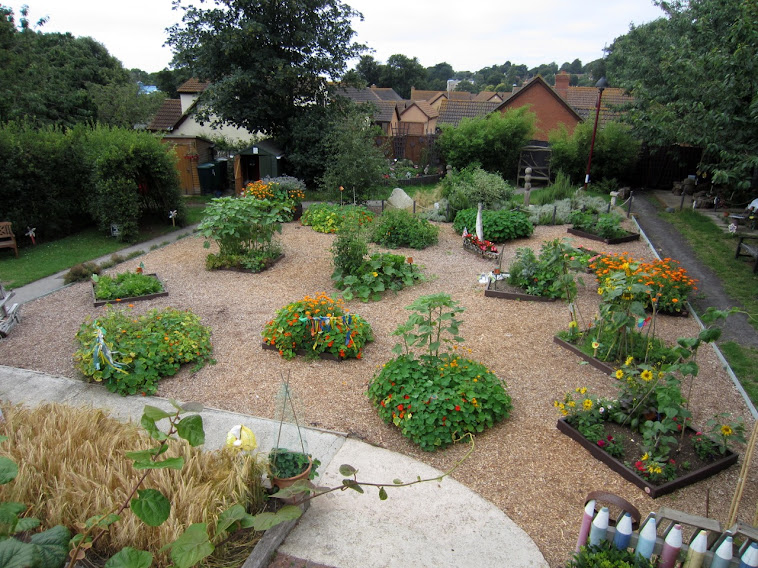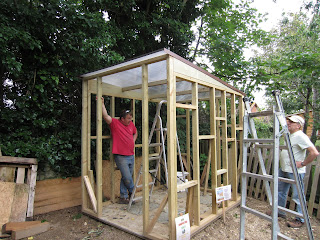|
|||||||||||||||||||||||||||||||||||||||||||||||||||||||||||||||||||||||||||||||||||||||
| If you remember Tuesday and Wednesday were downpours all day and kick started the serious flooding across South West Britain. | |||||||||||||||||||||||||||||||||||||||||||||||||||||||||||||||||||||||||||||||||||||||
| Yesterday the raspberry canes were planted in what was the old strawberry bed. In the greenhouse the sweet pea seeds were planted to give them a head start again ready for planting out in the Spring. | |||||||||||||||||||||||||||||||||||||||||||||||||||||||||||||||||||||||||||||||||||||||
| On the very last of the Ivy flowers the last few Ivy Colletes bees were making the most of the weather (and the flowers). But with the flowers all but over it was evident from the not-so-bulging pollen sacks that the year was nearly over for these bees. | |||||||||||||||||||||||||||||||||||||||||||||||||||||||||||||||||||||||||||||||||||||||
|
| |||||||||||||||||||||||||||||||||||||||||||||||||||||||||||||||||||||||||||||||||||||||
Follow us on our journey to create a wildlife friendly school garden that stimulates the imagination and helps the pupils to explore and learn about the wonders of nature
school garden

Wednesday 28 November 2012
Number crunching...
The first report from our weather station can be displayed
Sunday 25 November 2012
(Almost) A perfect pair...
Today the garden volunteers braved the heavy downpours and blustery wind to relocate the second palm tree and plant it alongside the other in the garden. For the time being we have finished tampering with the skyline!
The new palm trees have given definition to the main garden entrance, and although the Jurassic Garden is still at planning stage, when it is completed these trees will lead visitors,staff and children away from the Jurassic area and into the garden proper.
After fine tuning over the first week or so the weather station was downloaded today at the end of the first week proper. The radio transmitter from the weather station sends regular signals to the base unit and these are recorded in 30 minute intervals. After a week there is a lot of data to sift through! We are quickly learning how to interpret the data. Initially looking at the wind data over the last week two significant peaks were noted. On the 22nd November the wind gusted at 24mph in the late afternoon. However on the 25th November at 6am the wind gusted at 32mph from the SW.
We have lots of numbers to look at and hope to produce a weekly review of the weather at Holy Trinity Environmental Garden.
Friday 23 November 2012
That changing sky line.......
Once again the garden volunteers have been tampering with the skyline over the school garden. It all started last sunday when we were offered two mature palm trees for the school garden. The following pictures highlight the journey of the first tree.
This afternoon the tree was planted at the entrance to the garden. It is hoped that over the weekend the second tree can be transported and planted.
Whilst on the subject of trees the 'paper bark' birch trees which adorn the entrance to the Memory Garden are looking magnificent.
In the harsh light of Winter the almost tissue thin white bark purports a harsh contrast to the brown and grey colours left in the garden.
Finally as the day came to a close one of the local Robins burst forth into song in the Sycamore tree above our heads. This melancholic winter song has replaced the happy song of summer. Reminding us that it is a long hard road for the next few months!
Monday 12 November 2012
Weather the weather.....
The English are known for their obsession with the weather. Indeed Oscar Wilde is quoted as saying that "conversation about the weather is the last refuge of the unimaginative". That may be so but for many of us it is day to day conversation and those with hobbies and interests in the weather we cannot leave the topic alone.
Throwing caution to the wind on sunday the garden volunteers installed a full blown weather station. The data collected will be of use to individuals but also hopefully to the school as the collected data can be 'number crunched' into graphs and charts. Working with figures is great for education. Master figures and you have the world at your feet.
A closer look as you walk up the path will reveal the weather station
Inside the main shed is the display screen. Staff and pupils are welcome to look at the screen and take daily notes if they wish. Please though do not touch or move the display screen as it is quite fragile. All the data will be downloaded each week and the information then made available to the school if teachers would like to use the data as a tool to aid, and further, education.
We started this topic with a quote, so we will finish with another quote, about the weather. Mark Twain commented that "Climate is what we expect but weather is what we get"
Elsewhere.........
A lot of people decry Ivy but in the right place it is of great value especially at this time of year. It provides some of the last flowers of the year and many insects can often be found on a sunny day making the most of this. Yesterday the Ivy flowers about the school garden were covered in bees and hoverflies. The prominent bee though was the Ivy Colletes (Colletes hederae). This is a solitary, mining bee which occurs along the coast in Southern England and across Europe. The females are a little larger than the males. They look a little wasp like but they are certainly bees. They were very busy as they have to seal the egg chambers which are underground with a pollen/honey mix for the emerging adult next August or September.
The beauty of digital cameras is that you do not waste a roll of film just to get a couple of half decent pictures. Many pictures were taken but only three were considered for the blog
In all the pictures the pollen sacs ( the bulging yellow things which look like bicycle panniers) can be seen to be very full indicating the importance of this plant. The insect has orange brown hairs on the thorax. The striped body could give an immediate impression of a wasp.
Honey bees were also in evidence and several Hoverflies including the Dronefly, as it is called, Eristalis tenex.
Throwing caution to the wind on sunday the garden volunteers installed a full blown weather station. The data collected will be of use to individuals but also hopefully to the school as the collected data can be 'number crunched' into graphs and charts. Working with figures is great for education. Master figures and you have the world at your feet.
 |
| A new feature on the skyline |
A closer look as you walk up the path will reveal the weather station
 |
| |
We started this topic with a quote, so we will finish with another quote, about the weather. Mark Twain commented that "Climate is what we expect but weather is what we get"
Elsewhere.........
A lot of people decry Ivy but in the right place it is of great value especially at this time of year. It provides some of the last flowers of the year and many insects can often be found on a sunny day making the most of this. Yesterday the Ivy flowers about the school garden were covered in bees and hoverflies. The prominent bee though was the Ivy Colletes (Colletes hederae). This is a solitary, mining bee which occurs along the coast in Southern England and across Europe. The females are a little larger than the males. They look a little wasp like but they are certainly bees. They were very busy as they have to seal the egg chambers which are underground with a pollen/honey mix for the emerging adult next August or September.
The beauty of digital cameras is that you do not waste a roll of film just to get a couple of half decent pictures. Many pictures were taken but only three were considered for the blog
In all the pictures the pollen sacs ( the bulging yellow things which look like bicycle panniers) can be seen to be very full indicating the importance of this plant. The insect has orange brown hairs on the thorax. The striped body could give an immediate impression of a wasp.
Honey bees were also in evidence and several Hoverflies including the Dronefly, as it is called, Eristalis tenex.
Sunday 4 November 2012
They must have been listening....
Having mentioned in the last blog that the Living Stones would soon be flowering it was quite remarkable this morning to glance at them whilst tidying the greenhouse and there they were
Living Stones about to flower
A glance around the garden showed the leaves on many plants turning as Autumn is calling them to sleep for the Winter
 | ||
| Autumn often tests the artists pallette |
Wildlife is hanging on. A Migrant Hawker dragonfly was flitting about under the Sycamore trees for a while, a Red Admiral butterfly was plying the Ivy flowers along the boundary fence and a few Wasps were busy on the last remaining flowering heads of the cabbage plants. On the bird front a new species for the garden- Brambling- was noted. They replace the Chaffinch in the far north. They are orange rather than pink and when they fly away from you reveal a white rump. The numbers which visit depend on the success or failure of the Beech mast crop.
There have been large numbers of Jays about this Autumn - indeed three in the school grounds at the end of last week. These are Continental birds which have left due to the Acorn crop failure.there. Flocks of them were seen at coastal locations and in Britanny, France similar large numbers were seen two weeks ago.
Friday 2 November 2012
Up the garden path!
Today whilst dodging the afternoon showers the path to the eco-loo was constructed. At 1pm our friends from Doonan's delivered the dry mix and it was then a bit of a rush to get the path laid. The shuttering and hardcore had already been positioned so on paper it would not take long to make good. It seems a long time since we were at this stage
But at last we are now at this stage
A smaller path was also laid connecting the garden to the Garden Club beds
A busy day with the compost bins successfully moved away from the entrance and some general tidying up. The class beds are clear and ready for 2013 and our locally made compost has been distributed on some of the beds with more to follow.
At the close of day an interesting insect was noted on the roof of one of the cars. An Oak Bush-cricket. Usually seen indoors on the wall of the living room in the summer, as they are nocturnal, and often fly into a room where the light has been on and the window open.
 | |||
| Oak Bush-cricket |
It will soon be time to start overwintering the Pitcher Plants and those Living Stones should soon be in flower.
A timely reminder that summer may be hanging on was the fact that a Red Admiral butterfly was seen this afternoon in the garden.
Subscribe to:
Posts (Atom)
















